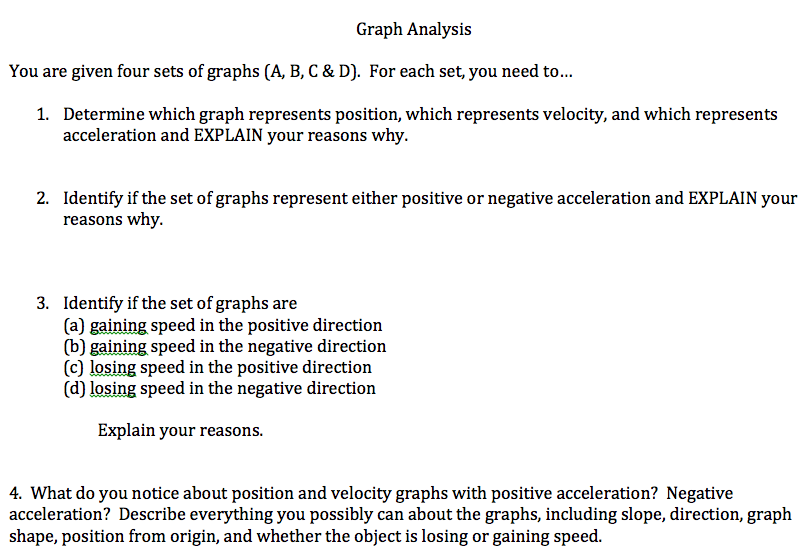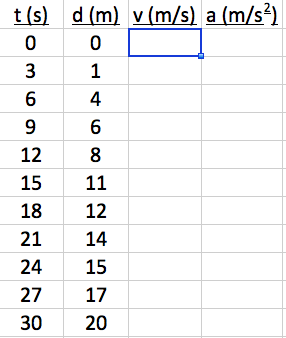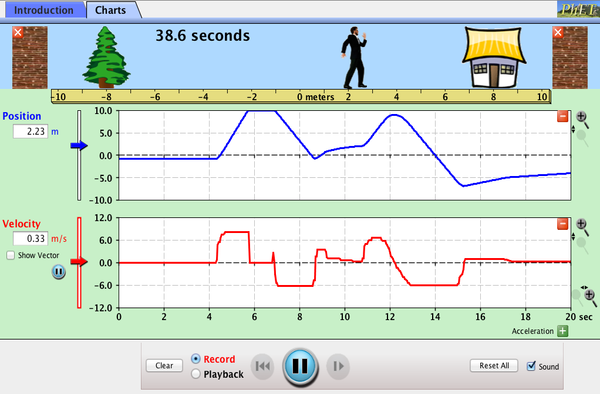Housekeeping: We are now investigating accelerated motion. While you're learning the material in class, you will also be working on designing the most efficient Hot Wheels track system that you must use to calculate velocity and acceleration of the cars. Instead of an actual lab write-up, you and your team of engineers will submit the actual design that you will use.
Content Review: Physics Classroom Physics Hypertextbook
Uniform & Accelerated Motion Velocity-Time Graphs
Student Missions:
Mission 1: Speed Demon
Mission Objectives: You should be able to...
1. Define "acceleration" in your own words.
2. Calculate acceleration given position & time graphs
3. Draw and interpret an acceleration-time graph
4. Use the motion equations in problem solving.
Let's backtrack for a few minutes. I forgot to talk about displacement. Basically, distance is a scalar quantity that describes movement between locations over an actual path connecting them. Displacement is a vector quantity that describes movement between locations over the shortest path connecting them.
Content Review: Physics Classroom Physics Hypertextbook
Uniform & Accelerated Motion Velocity-Time Graphs
Student Missions:
Mission 1: Speed Demon
Mission Objectives: You should be able to...
1. Define "acceleration" in your own words.
2. Calculate acceleration given position & time graphs
3. Draw and interpret an acceleration-time graph
4. Use the motion equations in problem solving.
Let's backtrack for a few minutes. I forgot to talk about displacement. Basically, distance is a scalar quantity that describes movement between locations over an actual path connecting them. Displacement is a vector quantity that describes movement between locations over the shortest path connecting them.
So if you were to do one lap on a standard track (400 m) and return to where you started, your distance would be 400 m, but your displacement would be 0 m because you ended up exactly where you began.
Take a look at these practice problems. Try to solve them before checking your answers.
I introduced the concept of acceleration last Wednesday, but we're really going to get into it this week as part of your prep for the Hot Wheels lab.
Before we do that, let's watch this clip from the movie Armageddon.
Take a look at these practice problems. Try to solve them before checking your answers.
I introduced the concept of acceleration last Wednesday, but we're really going to get into it this week as part of your prep for the Hot Wheels lab.
Before we do that, let's watch this clip from the movie Armageddon.
What you're seeing is the acceleration of the shuttles to reach maximum velocity in order to catch up with the asteroid. The pilots used the gravity of the moon as an assist to reach the maximum velocity of 22,500 mph.
For the record, NASA went metric back in 1990 (this movie came out in 1998). Convert 22,500 mph into kilometers per hour. What do you get?
Also, for the record, they shouldn't be able to breathe at that speed, much less scream. The immense G forces over that length of time should crush their lungs to the point where they can do little more than gasp for air and likely pass out. The maneuver would very likely kill them. However, this was a totally fun movie (in spite of the crap science) and I had a blast watching it in the theater.
Now, let's get into the actual science of acceleration.
For the record, NASA went metric back in 1990 (this movie came out in 1998). Convert 22,500 mph into kilometers per hour. What do you get?
Also, for the record, they shouldn't be able to breathe at that speed, much less scream. The immense G forces over that length of time should crush their lungs to the point where they can do little more than gasp for air and likely pass out. The maneuver would very likely kill them. However, this was a totally fun movie (in spite of the crap science) and I had a blast watching it in the theater.
Now, let's get into the actual science of acceleration.
This week, you guys will experiment with velocity and acceleration using Hot Wheels. You have to determine the velocity and acceleration of the cars using the track you're given. You also need to familiarize yourself with PhysicsTracker so that you can upload your videos and analyze the data.
Practice Problems
You'll start preparing for your first motion quiz (May 2) by completing the below assignment.
Practice Problems
You'll start preparing for your first motion quiz (May 2) by completing the below assignment.
Things to remember:
1. If the line slopes away from the x- (or time) axis, it is gaining speed; if it slopes towards the x- (or time) axis, it is losing speed.
2. If the velocity-time graph lies in the 4th quadrant, then the object is losing or gaining speed in a negative direction.
Also:
gaining speed (+) in a positive (+) direction + acceleration
gaining speed (+) in a negative (-) direction - acceleration
losing speed (-) in a positive (+) direction - acceleration
losing speed (-) in a negative (-) direction + acceleration
Source
1. If the line slopes away from the x- (or time) axis, it is gaining speed; if it slopes towards the x- (or time) axis, it is losing speed.
2. If the velocity-time graph lies in the 4th quadrant, then the object is losing or gaining speed in a negative direction.
Also:
gaining speed (+) in a positive (+) direction + acceleration
gaining speed (+) in a negative (-) direction - acceleration
losing speed (-) in a positive (+) direction - acceleration
losing speed (-) in a negative (-) direction + acceleration
Source
For the following exercise, you will work on your own. You have 45 minutes to complete the problem. You may use your notes.
You are given the following data. Do the following: (1) Calculate velocity and acceleration. (2) Graph position, velocity, and time. (3) Describe the velocity and acceleration graphs in terms of gaining/losing speed and +/- direction. Make sure each graph has a title and labeled axes with units. Remember that you must have three separate graphs.
Use Excel to do the calculations and graphs. Put everything in one document and upload it to Managebac under "Motion Practice Problem."
After you have uploaded your work, go ahead and work on your race track.
You are given the following data. Do the following: (1) Calculate velocity and acceleration. (2) Graph position, velocity, and time. (3) Describe the velocity and acceleration graphs in terms of gaining/losing speed and +/- direction. Make sure each graph has a title and labeled axes with units. Remember that you must have three separate graphs.
Use Excel to do the calculations and graphs. Put everything in one document and upload it to Managebac under "Motion Practice Problem."
After you have uploaded your work, go ahead and work on your race track.
This is how I want you to set up your Hot Wheels presentation. You will submit this on Friday at the beginning of the period. Today (May 15) is your last day to work on your Hot Wheels track.
| hot_wheels_presentation_design.pptx |



 RSS Feed
RSS Feed